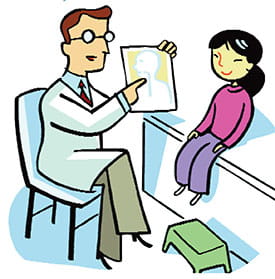The upper aerodigestive tract consists of the nose, the throat, the voice box, the windpipe, the lungs and the swallowing tube. A doctor might order an upper aerodigestive tract endoscopy if your child has:
- Problems swallowing, hoarseness or reflux (GERD)
- Noisy and difficult breathing (stridor) not related to tonsils, adenoids or asthma
- Inhaled a foreign object or swallowed a caustic liquid Had a surgery to the nose and/or throat
- A tumor in his or her airway
- A neck breathing tube, also called a tracheostomy (tray-kee-OST-oh-mee) or "trach" (TRAKE) tube, to check the size and position
An upper aerodigestive tract endoscopy might also be ordered if your child is too young to have — or was unable to tolerate — a flexible laryngoscopy (lair-en-GOSS-co-pee) in the doctor’s office.
To get a good look at the entire aerodigestive tract, the ENT doctor might use a number of different types of scopes. Some of the scopes that are used are "flexible." These soft, thin scopes are able to travel around angled areas, such as the back of the nose, and can even be used in patients when they are awake, allowing the ENT doctor to see things moving (like the vocal cords).
Some of the scopes that are used are "rigid" or hard. These bigger, hollow scopes provide higher quality images (pictures) of the body and allow the ENT doctor to do more tasks through them (such as take biopsies, remove foreign bodies or breathe for the patient). These bigger scopes can be used only when the patient is asleep with anesthesia medication.
During the upper aerodigestive tract endoscopy, the ENT doctor might pass into the nose a flexible scope (flexible rhinoscopy) or a rigid scope (rigid rhinoscopy). Often, a flexible scope passed into the nose is also used to examine the back of the throat (adenoids, soft palate, tonsils, base of tongue) and the voice box. This procedure is called flexible fiber-optic nasopharyngolaryngoscopy (NAY-so-FARE-in-go-LARE-in-GOSS-co-pee). That means a scope of the "naso," meaning nose, "pharyngo," meaning throat and "laryngo," meaning voice box, areas.
To look at the voice box more closely, rigid direct laryngoscopy is performed. The scope used for this part of the test is rigid, and the ENT doctor looks directly through it to actually see the voice box. The rigid laryngoscope consists of an eyepiece and a light that is enclosed in a metal case shaped to fit inside a child’s mouth. Once the laryngoscope is in place, the doctor also can pass a fiber-optic scope through it to take microscopic, magnified pictures of the larynx, if needed.
To see the windpipe, a long fiberoptic scope is placed past the voice box into the windpipe. This procedure is called a tracheoscopy (trake-ee-OSS-co-pee), meaning a scope of the trachea.
To see the food pipe or esophagus, a long tube with a fiber-optic camera is placed into the swallowing tube. This procedure is called esophageoscopy (e-SOFF-uh-gee-OSS-co-pee), or a scope of the esophagus.
To see the lungs, the scope is placed even further, and this procedure is called bronchoscopy (bronk-OSS-co-pee) or a scope of the bronchi, the large tubes of the lungs. The doctor also might perform a procedure called bronchial alveolar lavage (BRONK-ee-ul al-vee-OLE-ar la-vahj) or BAL. Using a sterile saline solution (similar to tears), the doctor will wash the lung area then draw out the solution and send it to the lab to be tested for foreign particles or infection. Sterile saline is completely safe to use inside the body. The doctor may also take an esophageal biopsy.
The scopes the doctor uses for the tracheoscopy, bronchoscopy and esophageoscopy might be flexible or rigid, depending on the size of the child and what the doctor needs to see in those areas of the aerodigestive tract.
Upper aerodigestive tract endoscopy is a safe way for doctors to examine these internal body parts; however, there are some risks involved. Although rare, these risks include possible swelling in the windpipe requiring special treatment and overnight observation; voice box injury; windpipe injury leading to escape of air and requiring a chest tube to re-expand the lungs; or infection in the chest, requiring surgical drainage and antibiotics. Your child’s doctor will discuss these risks with you prior to your child’s test.









 At
At